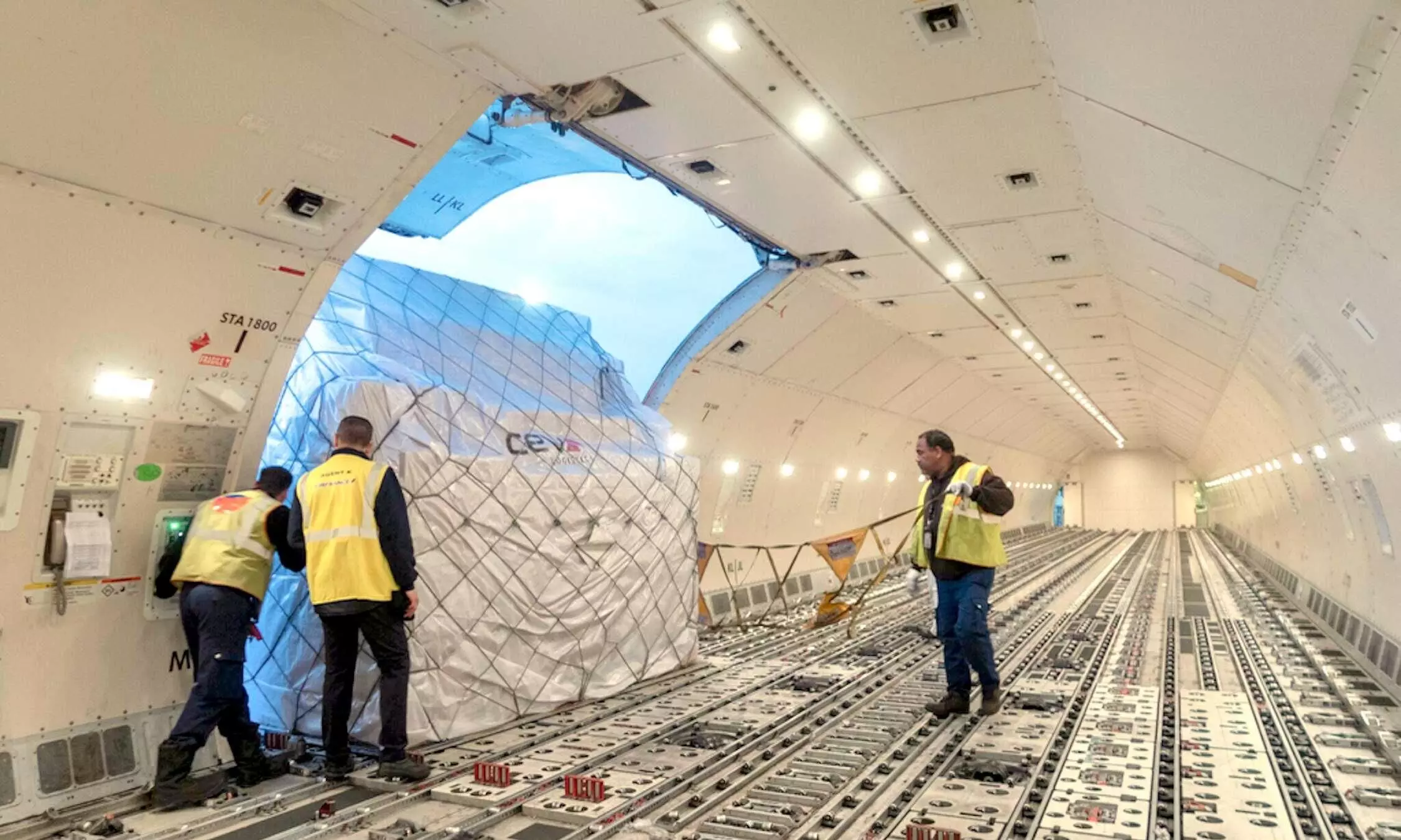
Sustained recovery still not in sight for transatlantic

In the near term, the transatlantic air cargo route is looking forward to a sustained recovery while low demand, increased capacity, and falling rates make it difficult. In the long term, the route can be seriously reoriented by the trends of e-commerce, nearshoring and the larger macroeconomic issues.
“There is a bigger downside risk for United States inbound demand than in Europe because the inflation in Europe is not due to an overheating economy but because of issues in the supply chain.”
This is how the chief airfreight officer of Xeneta Niall van de Wouw compares the two economies in the recent episode of STAT Media Group’s Cargo Masterminds.
“The real discretionary spending of US consumers has been improving for the last few months in a row so even if we take out inflation they have more money in their pockets to spend. This is reflected in the increased spending on durable goods. If you compare it with Europe it is a different story,” he says.
And, according to him, if we look at this in combination with the traditional airfreight seasonality, there will be a modest increase in their spending throughout the rest of this year.
However, it has got a flip side to it.
Citing the International Monetary Fund (IMF) data, he noted that 80 percent of the surge in inflation in the US is caused by overheating of the economy while it is only six percent in Europe.
“So there is a bigger downside risk next year for the US inbound demand,” he says.
“The volatility over the past several years placed a premium on relationships when looking at demand, capacity and rates."
Peter Penseel, CEVA Logistics
The transatlantic route is one of the most important trade routes for the world as it connects some of these important economies and countries. However, along with the challenges in these economies, the transatlantic air cargo market is facing a number of challenges, including weak demand, rising fuel costs, and increased competition from other modes of transportation. As a result, air freight rates are down from their peak levels in 2022.
On the same line with van de Wouw, the head of research at Freightos Judah Levine also estimates that sustained recovery on the transatlantic route won’t begin until Q2 of next year.
“There is some optimism for a moderate increase in demand and rates around peak season in Q4, and some carriers are sending freighters for maintenance during the current lull with loans to activate that capacity later in the year,” he says.
Freightos Air Index rates for the transatlantic are at $1.74/kg, down more than 40 percent from a year ago and 3% from last month. Prices fell from about $5/kg to $3/kg in the first half of 2022. Rates held at that level until about April of this year, but have decreased 40 percent to their current level since then.
“Year on year, ex-Asia rates have shown similar decreases, though ex-Asia prices have been largely stable since May. This discrepancy is likely due to the continued recovery in transatlantic tourism and passenger travel. Rates on the transatlantic, like those on other lanes, are nonetheless 10 percent or so above typical non-peak levels, likely due to higher fuel and labour costs still facing carriers,” he adds.
Globally, for international air cargo, sagging demand in increasing capacity as passenger travel recovers are combining to push rates down. The transatlantic air cargo market is no exception.
From the demand perspective, Levine also noted that “For air cargo, falling transatlantic ocean rates and faster transit times may also be pulling some demand away from modal shifts seen when ocean congestion and soaring rates pushed some volumes to air.”
“Some forwarders with committed volumes or still-committed charters are reportedly offering below-market prices as they compete for volumes,” he adds.
Meanwhile, bringing in the forwarders' perspective, Peter Penseel, chief operating officer, air freight, CEVA Logistics, noted that the transatlantic route will continue to be important for shippers, however, he said that “It will see downward effects on demand and pricing in the back half of 2023.”
“We are helping our customers maintain healthy relationships and a long-term view in their agreements with carriers. This relational approach ensures that everyone can take potential changes in stride and find solutions that are mutually beneficial while taking into account current market conditions. The volatility over the past several years placed a premium on relationships when looking at demand, capacity and rates,” he adds.
Unlike previous years, Penseel and Ceva Logistics are not anticipating a strong peak season in 2023.
He said, “We expect certain trade lanes (Asia-North America and Asia-Europe trade lanes) to see a mini-peak, but we do not see any strong movement on the demand side for the remainder of 2023. The interaction between the recovering demand and the growing capacity will continue to apply pressure on both rates and contract agreements.”
Penseel opines that the changing market conditions are leading to conversations around what the right commitments are from shippers, air carriers and forwarders.
“Capacity along certain trade routes will remain vital in the near term, so shippers need to remain focused on the long-term relationships with carriers and not simply look to pursue an aggressive rate negotiation. As markets swing back and forth, all sides at the table need to remain focused on the long-term partnership, prioritising long-term stability and trust over short-term gains,” he added.
“E-commerce continues to be one of the top commodities moved through YEG, as well as perishable products that require temperature control.”
Alex Lowe, Director, Edmonton International Airport
Along with this turbulence of air freight demand, capacity, rates and relationships, there has been a slight shift in the commodity mix on the transatlantic air cargo route as well.
For example, Brandon Fried, executive director of Airforwarders Association, says “Electronics and other high-value goods are still the most important commodities, but there has been an increase in demand for perishable goods and pharmaceuticals. Many Airforwarders Association members are now offering services in this area which is projected to grow significantly in the foreseeable future.”
E-commerce is the one sector that everybody wants to talk about in terms of the volumes it is bringing to air freight. For example, when asked about the changes in the commodities mix in the transatlantic air cargo, this is what Penseel said, “As a long-time industry veteran, I continue to be amazed at the growth of e-commerce logistics and its impact on the air freight market. The volume demanded in order to satisfy cross-border e-commerce shipments will be interesting to watch over the next few years.”
Alex Lowe, director of e-commerce, cargo & aviation real estate, Edmonton International Airport (YEG), calls e-commerce a major driver for growth for YEG.
“E-commerce continues to be one of the top commodities moved through YEG, as well as perishable products that require temperature control, like agri-food products, medicines, vaccines and other sensitive products. We continue to see strong demand in the manufacturing and equipment sectors and have seen growth in perishables and pharma,” he says.
Lowe told The STAT Trade Times that they are seeing an increase in transatlantic cargo volumes and year to date, their transatlantic volumes are up more than five percent.
He adds, “In May, we added a new non-stop route to Frankfurt with Condor, operating a wide-body passenger flight. This route increases our available transatlantic cargo capacity to our freight forwarders and shipping community. It is an important connection for restimulating and supporting our economy and by providing direct cargo access for Canadians and Europeans.”
However, there is a new trend that can affect and reorient cargo in the transatlantic in the medium to long term: nearshoring. Companies are moving production closer to their markets, which reduces the need for air freight. Along with this, the rise of Mexico as a global manufacturer can also change the air cargo equations in the transatlantic.
Even though many of the stakeholders reported no real effect of this happening right now in the air freight market, Fried opines that nearshoring and supply chain diversification are affecting the transatlantic air cargo market.
“The rise of Mexico as a manufacturing hub is also affecting the air cargo market. Mexico is becoming a more attractive destination for air freight because of its proximity to the United States and its lower labour costs. As supply chains begin to adopt a “China plus 1” approach, Mexico is viewed as a likely alternative to U.S. manufacturers seeking to mitigate risk while maintaining lower costs,” he added.
"Electronics and other high-value goods are still the most important commodities, but there has been an increase in demand for perishable goods and pharmaceuticals."
Brandon Fried, Airforwarders Association
Adding the airlines’ point of view, Delta Cargo spokesperson notes that transatlantic has been significantly impacted due to increased belly capacity (as a result of increased passenger demand and number of flights), combined with air cargo demand weakening.
“As a result, rates across the industry have fallen more than 50% from their peak and continue to decline. Industry-wide, transatlantic to US rates have experienced one of the largest declines of any flow to/from US, outside of APAC to US,” the spokesperson says.
He also notes that the air cargo industry normally experiences 3-4 year cycles of demand and if historical trends hold true, they are expecting demand to begin to bottom out in the near future, before starting to rebound.
“The rebound of international passenger traffic has had an impact on available cargo capacity per flight. However, in transatlantic the impact is being offset by the overall growth in the number of passenger flights, resulting in total capacity being up when comparing YoY and to pre-pandemic levels,” the spokesperson said.
Delta Cargo also notes that logistics professionals are most concerned with the European economic outlook and its impact on freight demand.
This was originally published in the September 2023 issue of The STAT Trade Times.

